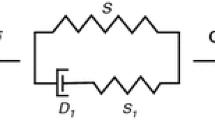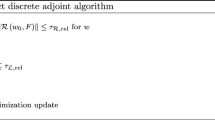Abstract
A method is presented for determining the optimal autoclave temperature history for pre-impregnated thermoset composites based on their failure performance. A coupled finite-element model that incorporates a thermochemical and incremental elastic analysis is used to predict the residual stress distribution at the edge of a thick composite beam. The optimal autoclave temperature is sought using a gradient-based optimization algorithm. The objective is designed to maximize the minimum failure load of the manufactured beam amongst a set of load cases, while the constraints are imposed to ensure that the composite is uniformly cured and does not sustain temperature damage during the manufacturing process. The hybrid-adjoint, a novel semi-analytic gradient evaluation technique is developed, that incorporates elements of both the adjoint and direct sensitivity methods. Results demonstrate that the method is highly accurate and competitive with a full adjoint approach for a moderate number of design variables.
Similar content being viewed by others
References
Alonso JJ, LeGresley P, van der Weide E, Martins JRRA, Reuther JJ (2004) pyMDO: a framework for high-fidelity multi-disciplinary optimization. AIAA Paper 2004-4480
Bogetti TA, Gillespie JW (1992) Process-induced stress and deformation in thick-section thermoset composite laminates. J Compos Mater 26(5):626–660
Domb MM, Hansen J (1993) Development of free-edge effect during processing of semicrystalline thermoplastic composites. AIAA J 31(5):1029–1033
Gill PE, Murray W, Saunders MA (2002) SNOPT: An SQP algorithm for large-scale constrained optimization. SIAM J Optim 12(4):979–1006
Gopal AK, Adali S, Verijenko VE (2000) Optimal temperature profiles for minimum residual stress in the cure process of polymer composites. Compos Struct 38:99–106
Hahn H, Kim KS (1989) Residual stress development during processing of graphite/epoxy composites. Compos Sci Technol 36(2):121–132
Halpin J, Kardos JL (1976) The Halpin-Tsai equations: a review. Polym Eng Sci (5)
Hansen J, Kennedy G, Almeida SFM (2005) A homogenization based theory for laminated and sandwich beams. In: 7th international conference on sandwich structures. Aalborg University, Aalborg, Denmark, pp 221–230
Johnston A, Vaziri R, Poursartip A (2001) A plane strain model for process-induced deformation of laminated composite structures. J Compos Mater 35(16):1435–1469
Jones RM (1996) Mechanics of composite materials. Technomic, Basel
Li M, Tucker CL III (2001) Optimal curing for thermoset matrix composites: thermochemical and consolidation considerations. Polym Compos 22(1):118–131
Li M, Zhu Q, Geubelle P, Tucker CL III (2001a) Dimensional accuracy of thermoset composites: simulation of process-induced residual stresses. J Compos Mater 35(24):2171–2205
Li M, Zhu Q, Geubelle P, Tucker CL III (2001b) Optimal curing for thermoset matrix composites: thermochemical considerations. Polym Compos 22(1):118–131
Lin KY, Hwang IH (1989) Thermo-viscoelastic analysis of composite materials. J Compos Mater 23(5):554–569
Loos AC, Springer GS (1983) Curing of epoxy matrix composites. J Compos Mater 17:135–169
Martins JRRA, Sturdza P, Alonso JJ (2003) The complex-step derivative approximation. ACM Trans Math Softw 29(3):245–262
Martins JRRA, Alonso JJ, Reuther JJ (2004) High-fidelity aerostructural design optimization of a supersonic business jet. J Aircr 41(3):523–530
Martins JRRA, Alonso JJ, Reuther JJ (2005) A coupled-adjoint sensitivity analysis method for high-fidelity aero-structural design. Optim Eng 6(1):33–62
Nemec M, Zingg DW (2002) A Newton-Krylov algorithm for aerodynamic design using the Navier-Stokes equations. AIAA J 40(6):1146–1154
Olhoff N (1989) Multicriterion structural optimization via bound formulation and mathematical programming. Struct Optim 1:11–17
Park H, Lee S (2001) Cure simulation of thick composite structures using the finite element method. J Compos Mater 35(3):188–201
Park HC, Goo NS, Min KJ, Yoon KJ (2003) Three-dimensional cure simulation of composite structures by the finite element method. Compos Struct 62:51–57
Pipes RB, Pagano NJ (1970) Interlaminar stresses in composite laminates under uniform axial extension. J Compos Mater, pp 538–548
Poon NMK, Martins JRRA (2007) An adaptive approach to constraint aggregation using adjoint sensitivity analysis. Struct Multidiscip Optim 30(1):61–73
Raspanti C, Bandoni J, Biegler L (2000) New strategies for flexibility analysis and design under uncertainty. Comput Chem Eng 24:2193–2209
Saad Y (1996) Iterative methods for sparse linear systems, 1st edn. PWS, Boston
Sobieszczanski-Sobieski J (1990) Sensitivity of complex, internally coupled systems. AIAA J 28(1):153–160
Sunderland P, Yu W, Manson JA (2001) A thermoviscoelastic analysis of process-induced internal stresses in thermoplastic matrix composites. Polym Compos 22(5):579–592
Unger WJ, Hansen JS (1993) The effect of cooling rate and annealing on residual stress development in graphite fibre reinforced PEEK laminates. J Compos Mater 27(2):108–137
White SR, Hahn HT (1992a) Process modeling of composite materials: residual stress development during cure. Part I: Model formulation. J Compos Mater 26(16):2402–2422
White SR, Hahn HT (1992b) Process modeling of composite materials: residual stress development during cure. Part II: Experimental validation. J Compos Mater 26(16):2423–2421
Wrenn G (1989) An indirect method for numerical optimization using the Kreisselmeier-Steinhauser function’. NASA Technical Report CR-4220
Author information
Authors and Affiliations
Corresponding author
Rights and permissions
About this article
Cite this article
Kennedy, G.J., Hansen, J.S. The hybrid-adjoint method: a semi-analytic gradient evaluation technique applied to composite cure cycle optimization. Optim Eng 11, 23–43 (2010). https://doi.org/10.1007/s11081-008-9068-9
Received:
Accepted:
Published:
Issue Date:
DOI: https://doi.org/10.1007/s11081-008-9068-9




